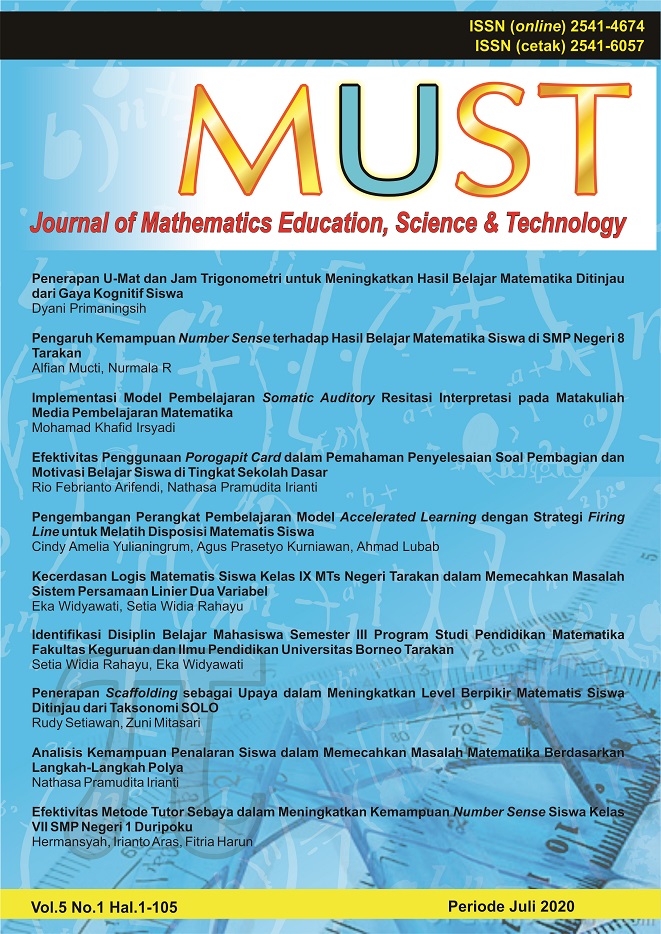Efektivitas Penggunaan Porogapit Card dalam Pemahaman Penyelesaian Soal Pembagian dan Motivasi Belajar Siswa di Tingkat Sekolah Dasar
Abstract
Full text article
References
Abdurrahman, M. (2010). Pendidikan bagi anak kesulitan belajar. Jakarta: Rineka Cipta.
Alavi, M., & Leidner, D. E. (2001). Research commentary: technology-mediated learning—a call for greater depth and breadth of research. Information Systems Research, 12(1), 1-10. http://doi.org/10.1287/isre.12.1.1.9720.
Benbunan-Fich, R., & Hiltz, S. R. (2003). Mediators of the effectiveness of online courses. IEEE Transactions on Professional Communication, 46(4), 298-312. http://doi.org/10.1109/tpc.2003.819639.
BSNP. (2006). Permendiknas RI no. 22 tahun 2006 tentang standar isi untuk satuan pendidikan dasar dan menengah. Jakarta.
Camos, V., & Baumer, J. (2015). Why is it so hard to solve long divisions for 10-year-old children? International Journal of School and Cognitive Psychology, S2: 007. http://doi.org/10.4172/2469-9837.1000S2-007.
Dohaney J., Brogt E., Wilson T.M., Kennedy B. (2017). Using role-play to improve students’ confidence and perceptions of communication in a simulated volcanic crisis. In: Fearnley C.J., Bird D.K., Haynes K., McGuire W.J., Jolly G. (eds) Observing the Volcano World. Advances in Volcanology (An Official Book Series of the International Association of Volcanology and Chemistry of the Earth’s Interior – IAVCEI, Barcelona, Spain). Springer, Cham. http://doi.org/10.1007/11157_2016_50.
Dündar, Ş., Güvendir, M.A., Kocabıyık, O.O., & Papatga, E. (2014). Which elementary school subjects are the most likeable, most important, and the easiest? why?: a study of science and technology, mathematics, social studies, and Turkish. Educational Research and Reviews, 9(13), 417-428. http://doi.org/10.5897/ERR2014.1755.
Hoque, E. (2018). Memorization: a proven method of learning. International Journal of Applied Research, 22, 142-150.
Keller, J. M. (2009). The arcs model of motivational design. In: Motivational design for learning and performance. Boston: Springer. http://doi.org/10.1007/978-1-4419-1250-3_3.
Liaw, S.-S., Huang, H.-M., & Chen, G.-D. (2007). Surveying instructor and learner attitudes toward e-learning. Computers & Education, 49(4), 1066-1080. http://doi.org/10.1016/j.compedu.2006.01.001.
Nurhayati, N., Rosmaiyadi, R., & Buyung, B. (2017). Efforts to improve student’s self confidence using collaborative learning model. JPMI (Jurnal Pendidikan Matematika Indonesia), 2(2), 57-62. http://doi.org/10.26737/jpmi.v2i2.223.
Setyono, A. (2007). Mathemagic cara genius belajar matematika, Jakarta: Gramedia Pustaka Utama.
Wigfield, A., & Cambria, J. (2010). Students’ achievement values, goal orientations, and interest: definitions, development, and relations to achievement outcomes. Developmental Review, 30(1), 1-35. http://doi.org/10.1016/j.dr.2009.12.001.
Authors
Authors who publish with this journal agree to the following terms:
- Authors retain copyright and grant the journal right of first publication with the work simultaneously licensed under a Creative Commons Attribution-NonCommercial 4.0 International License that allows others to share the work with an acknowledgment of the work's authorship and initial publication in this journal.
- Authors are able to enter into separate, additional contractual arrangements for the non-exclusive distribution of the journal's published version of the work (e.g., post it to an institutional repository or publish it in a book), with an acknowledgment of its initial publication in this journal.
- Authors are permitted and encouraged to post their work online (e.g., in institutional repositories or on their website) prior to and during the submission process, as it can lead to productive exchanges, as well as earlier and greater citation of published work

